A Botany of Desire
Gardener Liz Knowles’ passion for rare yet rugged alpine flora has transformed her Mono gardens into more than an aesthetic triumph. They’re an aide memoire of her life and travels 40 years on.
If you visit Liz and George Knowles any time other than full-on winter, there’s really no point in knocking on their door. Best to search first in the gardens that unfurl north from the house and multiple nursery sheds. If they’re not on their knees weeding, planting or transplanting, they’re likely hauling compost or mulch across what little lawn remains on this 11-acre Mono property.
The bonus: Any hunt for the pair here at Larkspur Hollow, where the now-retired couple have lived, raised two daughters and gardened since 1976, is an excuse to wander through a magical landscape that inspires delight at every turn.
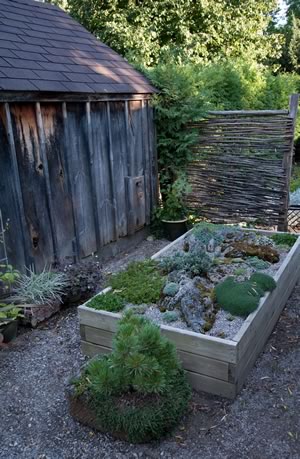
One of Liz Knowles’ tufa beds, in which she grows some of her favourite alpine plants. Photo by Rosemary Hasner / Black Dog Creative Arts.
A summer visit means the rock gardens and multiple perennial beds are awash with painterly blooms in yellows, purples and pinks, and the two ponds are bursting with life and lily pads. A little later in the season and the grass garden on the north hill will be swaying in the breeze and the nearby market-worthy vegetable garden will be bursting with quirky varieties of heritage potatoes and tomatoes and waist-high chard and kale.
Early in the season, I find Liz and George willing to dust off the morning’s dirt, sit on a porch overlooking their labour of love and chat with me about their very personal take on horticulture.
“It’s what we love doing. I’d rather be here than inside,” says Liz.
Contemplating their evolution over time, Liz says the gardens that curve across the gentle hillside, some linked by gravel pathways, have increasingly become “a reflection of places we’ve been.”
And lest you think Liz is referring to famous manicured botanical gardens abroad, she isn’t. Many of the individual blooms are here because Liz and George fell in love with them, or their close relatives, in the wild during travels in pursuit of botanical wonders in remote alpine outposts in Europe, China, Central Asia and India.
The couple are taken with the kind of trips that require sturdy backpacks and stays in Soviet-era apartments or tents at thousands of feet above sea level, meals taken in yurts, and treks through rugged mountain valleys or fields of claggy mud – the kind that coats your boots and threatens to dislodge them from your feet. Yet as remote and foreign as, say, the Himalayas may seem, “the climate is not that dissimilar to ours,” says Liz. (She notes that on a recent birding trip to Costa Rica, she and George weren’t entirely comfortable in the warmth of the coastal lowlands and breathed a sigh of relief when their itinerary took them to the crisp alpine air at 10,000 feet.)
The rewards are long vistas of rare lilies, irises or poppies filling in rocky crags in Uzbekistan, Kyrgyzstan or North West India, and the sheer wonder of looking at a plant thriving in its natural habitat, in conditions that can only be described as “ice water and mud.”
“You look at that and think, how does it grow?” says Liz, adding her now-predictable follow-up question, “How can I grow that?” Liz, who organized and led such expeditions for six years, is known locally and internationally as an expert (botanical nomenclature trips off her tongue like a second language) and she recently won an award for a piece on her Silk Road travels in the journal of the Alpine Garden Society.
One of their favourite memories is of standing knee-deep in a field of yellow alpine poppies in Vail, Colorado. “This is why we travel,” says Liz.
Scrambling along a mountainside to behold spectacular floral scenes is a rush, but each trip also adds to the to-do list at Larkspur Hollow. While some folks collect souvenir T-shirts or mugs, Liz collects names of species to try here in her Mono soil. On a trip to Iran in 2011, for instance, there was an Iris fosteriana she is now trying to cultivate here. “If I ever get it to grow, boy, I’ll be very happy.”
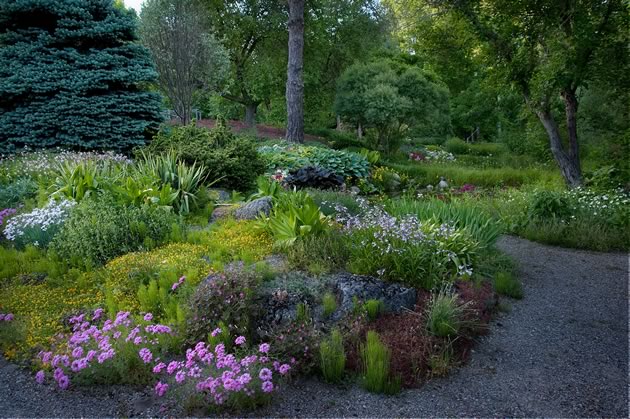
An enchanting spring view of an interconnected series of Liz Knowles’ gardens, including a sand bed in the foreground with its pink Verbena canadensis, yellow dianthus and pale purple penstemon. Hits of white and fuchsia Primula japonica dot the edges of two small ponds. Photo by Rosemary Hasner / Black Dog Creative Arts.
Living souvenirs
Back home, while the overall aesthetic of Larkspur Hollow is a breathtaking masterpiece of formal yet natural style, the gardens are in some ways more about the individual marvels Liz has coaxed along than the magazine-worthy big picture. These are gardens for strolling and noticing.
In the frequent talks she has given about their garden, Liz says she relies on the phrase “echoes of wild places” as shorthand for her inspirations. George jumps in to make sure it’s clear that Liz is the driving force – “I just prepare the canvas. Lizzie’s the artist.”
As such, one of Liz’s go-to tools is yellow saxifrage, also known as a “rock breaker” for its will to live in austere conditions. Her memory of seeing wild versions in the Pyrenees lives on here via hybrids such as Saxifraga ‘Kasper Stein’ and Saxifraga ‘Winton Harding.’ Of a candy-striped Arisaema elephas of Chinese origin (flashy cousin to our wild jack-in-the-pulpit) that blooms in summer with massive leaves, she says they are “truly hardy – they’re happy here. It’s a high.”
But it’s not just the obviously hardy that fill her heart with pleasure. Liz’s travels have altered her perception of plants she once considered too delicate and tender to grow here or in need of helicopter gardening to keep alive. In the wild, for instance, Iranian tulips bloom in dry, inhospitable places, only requiring a moist start to set them in motion. So here at Larkspur Hollow, after typically moist springs, she doesn’t worry. “It makes you realize, when we think we’re so clever, mother nature has done it all before.”
Often flora that catch her eye can lead Liz on a journey through botanical and cultural history on the way to planting them in her gardens. The unusual yellow Primula bulleyana that flourishes in the garden is credited to British cotton merchant Arthur Bulley (1861–1942). It was one of the plants discovered on exploratory plant-hunting trips he sponsored to China. He went on to create the Ness Botanic Gardens, now run by the University of Liverpool. In another example, the floaty purple Iris tectorum she grows is a species that first caught her attention in Yunnan, China. Tectorum is Latin for “of the roof,” and westerners first saw it growing on thatch rooftops in Asia, hence the common name “roof iris.”
In case you’re wondering, no, the pair doesn’t flout international regulations and sneak samples to bring home. They trade seeds aboveboard by mail with groups of likeminded folks at the Scottish Rock Garden Club or the Worcestershire, U.K.-based Alpine Garden Society. Just as Liz pines for species from abroad, members of those groups crave species, such as cardinal flower and trillium, native to Ontario.
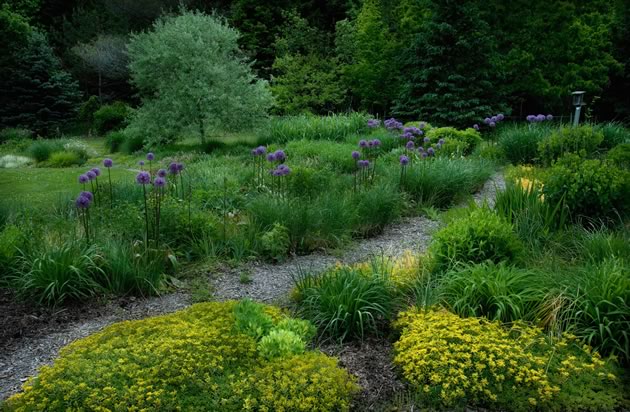
In spring, Liz Knowles’ gardens burst into life. Photo by Rosemary Hasner / Black Dog Creative Arts.
The gardens’ beginnings
The Knowles’ all-consuming intellectual and physical pursuit started innocently enough. After moving to Mono, the pair wanted to link a few disparate trees with cohesive perennial gardens and began to carve out spaces on the lawns north of the house.
Once bitten by the gardening bug, they were propelled over time to create more than 10 distinct plots and pond gardens. Early on, Liz created a circular herb garden that evolved into the “rabbit-resistant garden” as she chose increasingly untasty greens. It now teems with thymes and lavender. Like many garden obsessives, there have been a few declarations of “no more gardens” over the years, but they just haven’t stuck. (New this year is a low-lying bed grown in tufa, a porous rock, in the nursery area near the house. Liz hopes the miniature rock garden will settle in and come to thrive over the next five years as others have.)
By the 1990s the pair was head over heels for their gardens, spending most of their spare time hauling soil, compost and mulch, and planting. George joined Liz full time in 2009 after he retired completely, and he doubled down on his now 40 x 100-foot vegetable garden. It is enclosed by rustic wood and page-wire fencing and is as lush and orderly as Liz’s flower gardens. (Another of George’s boasting rights: He hand-weeded the lawn’s dandelion population into oblivion.) The pair’s sophisticated compost system is impossibly tidy and produces impressive quantities of nutrient-rich top-dressing. Mulch is a thick and healthy layer of chopped-up leaves. Deer are held at bay by discreet electric fencing surrounding the property. Liz insists none of this actually feels like work.
The naturalistic rock gardens which occupy a slope running diagonally west across the property were a project begun in 2008, in part to accommodate Liz’s growing interest in alpine gems. Heavy machinery was required to move giant local rocks into place to form a dragonesque “spine” delineating the crest of the ridge. These gardens come alive in mid- to late-May, as spring blooms and hardy alpine species emerge – a view the pair like to survey from their second-floor balcony.
On the flat expanse at the top of the hill, Liz admits the inspiration for the graceful boomerang-shaped grass garden she started in 2005 was as much pragmatic as artful. She wanted to deal with the unappealing divots bug-seeking skunks were leaving in the lawn. Out came the rototiller and a plan for a garden devoted to ornamental grasses, some of which now reach 12 feet tall in late summer. Their gauzy seed heads make for an impressionistic focal point well through fall. Tucked among the grasses are more treasures, including spring bulbs that carpet the bed with colour before the grasses emerge, and later in the summer, coneflower and Russian sage. Weeds and unwelcome grasses are deterred by an eight-inch-deep gravel border.
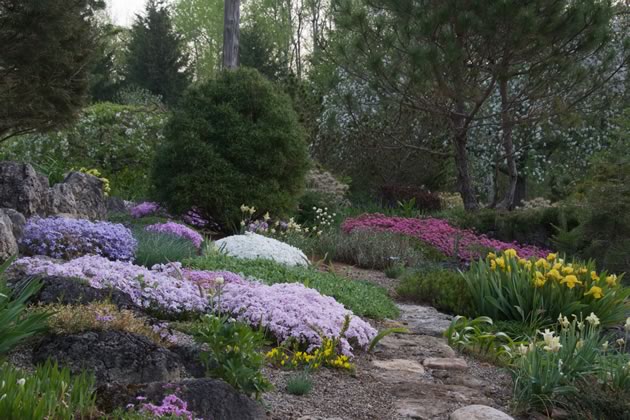
Painterly dabs of colour announce spring in one of the rock gardens. Photo by Liz Knowles.
Winter reflections
While winter is certainly a time for Liz and George to slow down and reflect on the successes of each growing season, there are still plenty of reasons to pad around outside in the snow, especially the grey bark and sculptural droop of the Malus ‘Red Jade’ – which in summer floats over a bed of mauve Anemone blanda – and the red-flecked Berberis koreana ‘Red Tears’ which enlivens the white landscape.
On a recent winter visit, I find their passion for photography is keeping the gardens alive, albeit digitally and indoors, until spring. The monitor in their bright, airy study runs a constant slide show of blooms at their best, both here and abroad.
A novice might ogle the shock of pink creeping phlox that pools out from under an evergreen in one photo, but Liz zeroes in on more hard-won or personally meaningful moments, such as a grouping of Helleborus niger popping up in the centre of a sea of pink Corydalis solida, a pinky Daphne cneorum blooming two metres wide last Mother’s Day, or merely the reminder that of one of her umbrella plants (Darmera peltata) always conjures up Dr. Seuss in her mind’s eye.
Beloved though these all may be, Liz isn’t one to wrap, cover or coddle her charges. As part of her tough love approach, she has no qualms about moving her star players around and risking a failed transplant. (As we’re discussing this, George offers a riddle – Q: How do you define a perennial? A: A plant that spends 50 per cent of its life in a wheelbarrow.)
Looking at an old map of the gardens in her lovingly compiled scrapbook, Liz is quick to correct the names and contents of almost half the gardens she diagrammed back in the 1990s. Trees had died or were felled, certain other plants also perished, or were moved when a better idea came along. The golden mock orange gave way to the beech bed, the corkscrew hazel bed is now the Korean pine bed.
“Gardening is a fluid thing,” she says. “In this climate so much is determined by weather.”
For an avid gardener, no weather is more exciting than spring weather. On that winter visit, Liz zeroes in on a photo from last year of a patch of unfurling pink Helleborus thibetanus shoots, their roots still surrounded by snow. Although not given to sentimentality, she is clearly amazed at this evidence of her gardens’ state of “constant transformation” as one season gives way to the next. And she is just as clearly excited by the transformation she and George will soon undergo as spring beckons them back outside.
If you need Liz or George, you’ll know where to find them.
~~~
Don’t miss this four-season gallery of Liz Knowles’ gardens. Click here for a look at the botanical stars of her gardens. And check out our Editor’s Desk for more on Liz’s history in Mono.
Related Stories
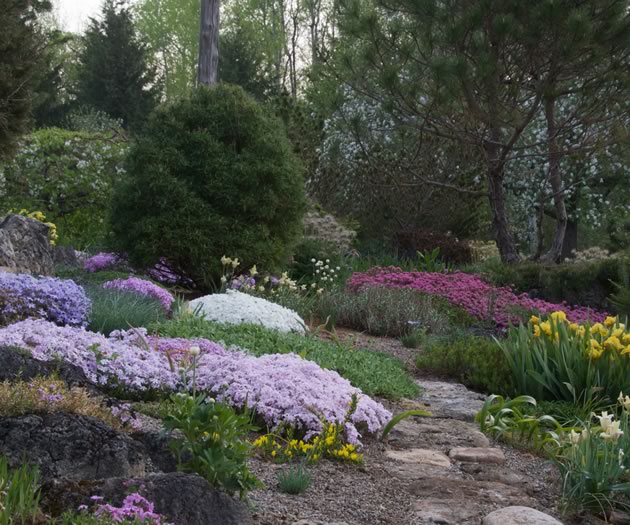
Take a Tour of Larkspur Hollow
Mar 20, 2017 | | LeisureAt their garden in Mono, Liz and George Knowles garden with an eye to all four seasons.
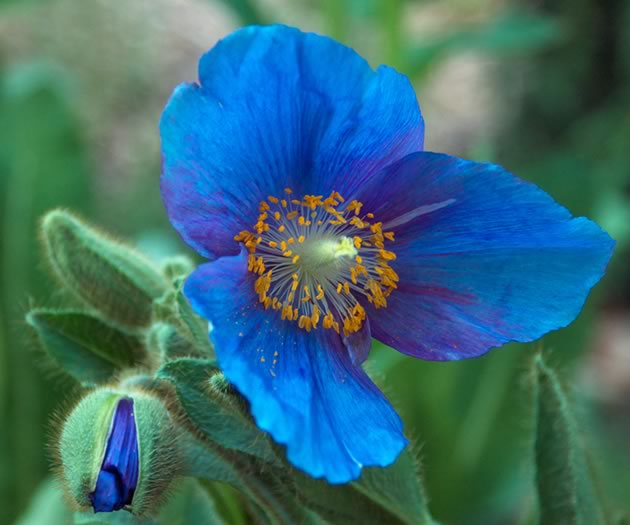
Stars of Larkspur Hollow
Mar 20, 2017 | | LeisureUp close and personal with some of the stars of Liz Knowles’ garden – many of them from alpine destinations in Central Asia, China and India.
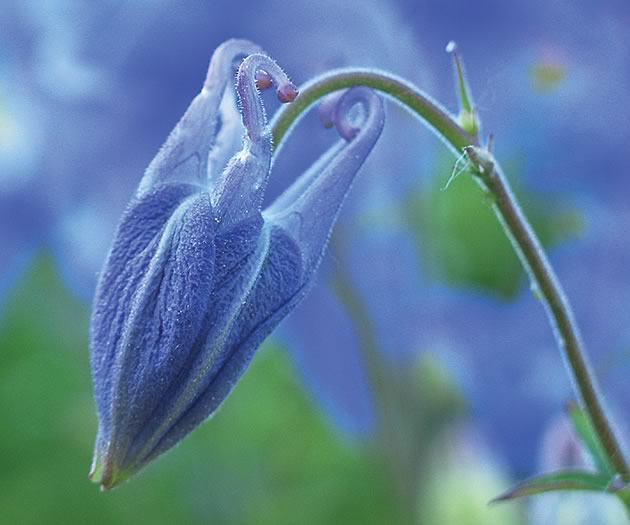
Pure Tranquility. Sheer Glory.
Mar 21, 2005 | | LeisureIn Amy Stewart’s Caledon garden, the soul of garden and gardener are one.
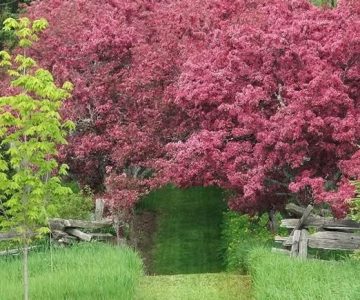
Spring at Lilactree Farm
Mar 23, 2012 | | LeisureAn allée of ‘Profusion’ crabapples at Lilactree Farm in Mulmur.
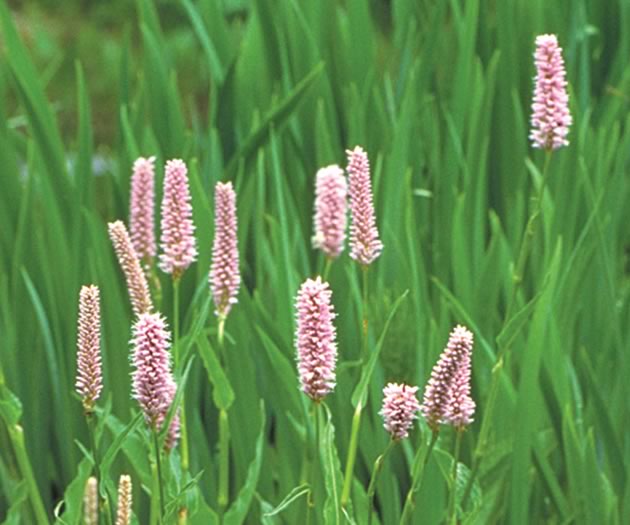
Summer Prelude
Mar 21, 2005 | | Back IssuesBefore June’s big show, spring’s late bloomers provide a dazzling warm-up act.
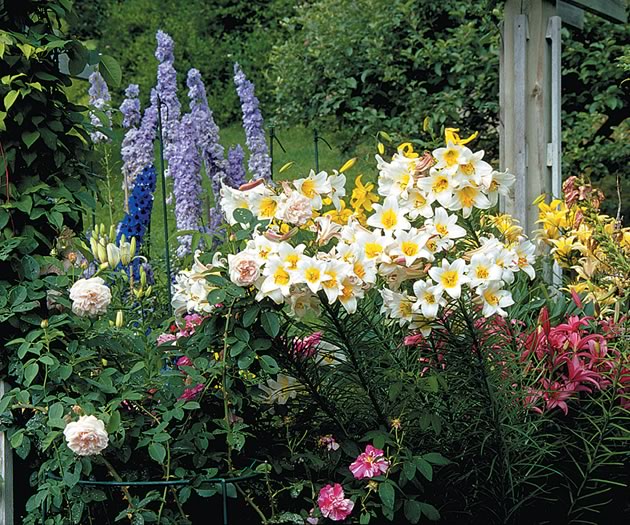
The Artist’s Garden
Mar 21, 2003 | | LeisureArt and gardening inspire each other to superlative effect in the botanical pursuits of two local artists.









Hello Liz,
My name is Joy McWhirter. I’m speaker chair for Newmarket Garden Club. May I have contact info for you, thank you.
Joy
Joy McWhirter from Newmarket, Ont. on Nov 1, 2022 at 12:01 pm |